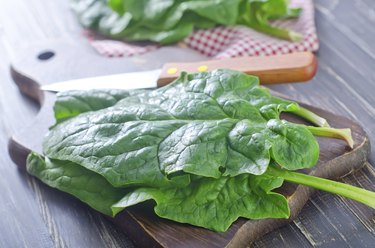
Spinach is a leafy green vegetable rich in vitamins, minerals, dietary fiber, antioxidants and phytochemicals. One of the many nutrients found in spinach is potassium, an essential mineral and electrolyte. Normal functioning of the human body depends on tight regulation of potassium inside and outside of the cells. Eating spinach will help you meet your daily potassium needs. Eaten raw or cooked, spinach packs a nutritional punch.
Function of Potassium
Video of the Day
Potassium is found in all cells in your body. As an electrolyte, potassium has the ability to dissociate into ions and conduct electricity. It is vital for skeletal and smooth muscle contraction and plays a key role in normal muscle, heart and digestive function. It works closely with sodium to control your body's electrolyte and fluid balance. Potassium also helps lower blood pressure and reduce your risk of stroke.
Video of the Day
Dietary Allowance
The Food and Nutrition Board of the Institute of Medicine established adequate intake levels for potassium based on the amount needed to lower blood pressure, reduce salt sensitivity and minimize the risk of kidney stones. Babies up to 6 months old require 400 milligrams, while infants ages 7 to 12 months need 700 milligrams of potassium daily. Older children need between 3,000 and 4,500 milligrams daily, depending on age. Adolescents and adults require a little more per day -- at least 4,700 milligrams. The richest sources of potassium are fruits and vegetables, so aim for five servings of fresh produce daily. Legumes, fish, meat and some dairy products also contribute to your daily potassium intake.
Spinach
While it is important to eat a variety of colorful fruits and vegetables daily, dark green spinach is especially healthy. Chlorophyll is the pigment that gives spinach its deep color, and it helps maintain vision, strong bones and teeth, and lowers the risk of certain types of cancer. Spinach consists of bright green, thick, oval-shaped small and medium leaves with green stems. You can eat both the leaves and the stems. Savoy, flat leaf and semi-savoy are the most common types of spinach, each with a distinct flavor, texture and common use.
Potassium in Spinach
Spinach is a good source of dietary fiber and many vitamins and minerals, especially vitamin K, folate, manganese, iron and magnesium. The green pigmentation of spinach indicates it is a rich source of antioxidants such as beta-carotene, a form of vitamin A. Spinach is also packed with potassium. On average, 1 cup of raw spinach leaves contain 167 milligrams, while 1 cup of cooked spinach contains 840 milligrams of potassium.
Raw vs. Cooked Spinach
Most vegetables lose their nutritional value when cooked and should be eaten raw whenever possible. However, this is not the case with spinach. Cooking some vegetables can actually boost their antioxidant and mineral content. Heating causes the cell walls of vegetables to break down more readily and release vitamins and minerals such as potassium. Additionally, spinach contains a compound known as oxalic acid that binds with calcium and other minerals, reducing their absorption. Cooking releases minerals, increasing the amount of potassium, calcium and magnesium available for your body. This is why cooked spinach contains more available potassium.
- Linus Pauling Institute; "Potassium"; Jane Higdon; December 2010
- Waverly Health Center: Potassium – How Much Do You Need?
- California Department of Public Health Network for A Healthy California: Harvest of the Month -- Spinach
- Globe and Mail: "Is Spinach More Nutritious Raw or Cooked?"; Leslie Beck; February 2011
- University of Maryland Medical Center; "Potassium"; Steven Ehrlich; May 2009
- \Weight Watchers; "Spinach"; Rich Rubin
- Nutrition Keynotes: Potassium Content of Foods